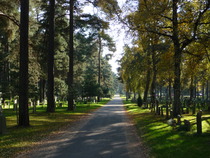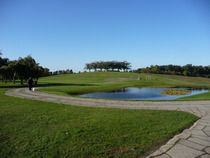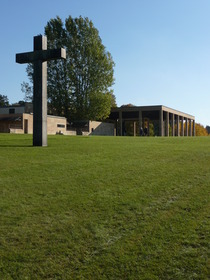Skogskyrkogården (World Heritage)
The Woodland Cemetery UNESCO World Heritage in Enskede in the southern suburbs of Stockholm was created during the period 1919 to 1940, and was a pioneer in the design of cemeteries throughout the world. Architects Gunnar Asplund and Sigurd Lewerentz used the landscape, and have created a cemetery that is characterised by a sensitive unity of the natural world with the built environment.
Tallum
An international architectural competition was announced in 1914 for the design of a major expansion of Sandsborgskyrkogården in Enskede, south of Stockholm. The result would be the Woodland Cemetery. The background to the location of Stockholm’s largest cemetery a considerable distance outside of the then city limit lay in problems with the city cemeteries of the 19th century. These could no longer cope with the increasing number of funerals due to reasons of hygiene, and due to the hard competition for land. There were several advantages to using the forest that had been chosen for the expansion of the Sandsborgskyrkogård. The land was owned by the government, the sand ridge that dominated the region was of the correct composition, and the newly laid tramlines provided good transport connections with the inner city. The competition programme had been influenced by modern German forestry cemeteries, and thus expressed a desire that the natural value of the landscape should be preserved, while at the same time it should be easy for the public to gain an overview and orient themselves in the cemetery. Architects Gunnar Asplund and Sigurd Lewerentz won the competition in 1915, with their design, “Tallum”.
The largest cemetery in Sweden
It was, however, necessary to refine the winning proposal following the wishes of the commissioner, from an atmosphere of untouched nature to a more clearly defined architectonic feeling. This led to more a profound impact on the landscape in order to create defined valleys, deciduous copses and open spaces. The main entrance to the Woodland Cemetery and the burial plots were designed by Lewerentz, while Asplund designed the first chapel, the Woodland Chapel, which was opened in 1920. A period of crisis after the First World War led to the chapel being built rather more simply and smaller than originally planned, and it was built from wood with a pyramidal roof. A larger chapel was added to the plans at an early stage, and this was designed by Lewerentz, using the popular classicist style of the period. This chapel was opened in 1925. The building was given the name the Chapel of Resurrection and has the distinct look of an ancient Greek temple.
The use of a new form of funeral, cremation, started to grow towards the end of the 1920s and a need for new crematoriums arose, in Stockholm and other locations. This led to plans being drawn up for a principal chapel with an associated crematorium at the Woodland Cemetery in 1934, and the Woodland Crematorium with its three chapels, Faith, Hope and the Holy Cross, was opened in 1940. All had been designed by Gunnar Asplund. The external expression of the building is perpendicular, asymmetrically functionalistic and monumental, while the gardens and the inner chapel have been given rounder and more intimate forms.
The Woodland Cemetery is the largest cemetery in Sweden, covering an area of 100 hectares, which corresponds to over 140 football pitches. There are over 90,000 graves here, and more than 2,000 burials take place each year in the five chapels.
World Heritage The Woodland Cemetery was added to the UNESCO World Heritage List in 1994 with the following motivation: “The Woodland Cemetery is an outstanding example of how architecture and a formed cultural landscape from our century can be united into a cemetery. This creation has had a major influence on the design of cemeteries throughout the world.”
Entrance to the Visitors’ Centre at the Woodland Cemetery is free of charge and it is open 11 am-4 pm every Sunday in May and September, and every day from the last Sunday in May until the last Sunday in August. It is open also on United Nations Day (24 October) and at the weekend of All Saints’ Day (Friday and Sunday).
A map and introductory guide downloaded from the World Heritage webpage in several languages from http://www.skogskyrkogarden.se/en/visiting/visitors-guide.php.
Links
World Heritage Properties
UNESCO and the World Heritage List
Skogskyrkogåden
Nearest public transport is the SL Metro stop at Skogskyrkogården.



